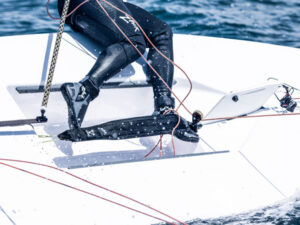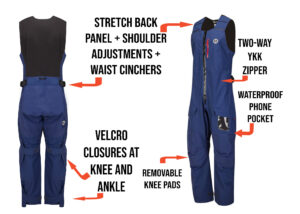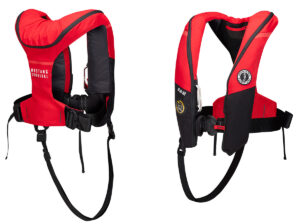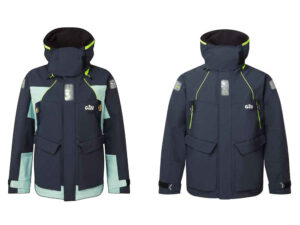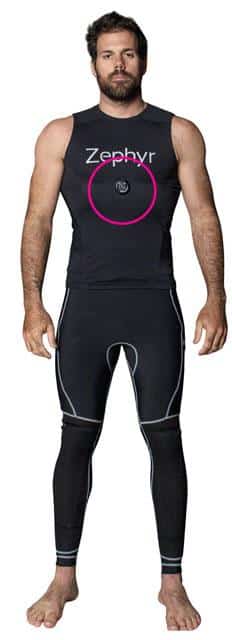
San Francisco is a tough environment for sailing gear, says Oracle Team USA’s Shannon Falcone, who is in charge of developing every piece of technical clothing he and his teammates will don come September’s 34th Match. The water is cold, air temperatures swing dramatically, and 30-minute, sweat-inducing bursts are followed by long, chilling waits. Then there’s the critical safety gear, the importance of which was emphasized by pre-Cup training capsizes by Oracle and Artemis Racing. No off-the-shelf sailing gear exists for the extremities of the 34th America’s Cup, so Oracle’s kit is custom, high-performance technical gear. And changing safety requirements expected from AC race officials will see more refinements yet, including additional body armor, stronger more visible helmets, and higher visibility colors in the clothing. There are a lot of pieces to put on before sailing, and Falcone says, “We have 15 minutes built into the race-day schedule to get dressed.” Let’s take a look at the essential elements to an AC34 crewmember’s battle gear, developed during Oracle’s early AC72 training.
Zephyr top
The sensor puck built into Zephyr’s Team BioHarness 3 Compression Shirt (at chest) records heart rate, breathing rate, and body temperature. The team’s performance coach downloads the data after sailing to track each sailor’s individual workloads and calorie consumption.

Lycra pants and shirt
This lightweight, wicking thermal layer is worn on race days. Designed in conjunction with PUMA and Zhik, the base layer’s pants have shin guards. “Running into a loaded wing sheet as you’re crossing the tramp is like hitting rebar,” says Falcone. “It can really take you out.”
The long-sleeved shirt is loose fitting so it doesn’t restrict the arm rotation of the grinders. Following recommendations from an America’s Cup-appointed safety review committee, Falcone is also exploring the integration of additional body armor into other areas (spine and chest, for example) of the base layers.
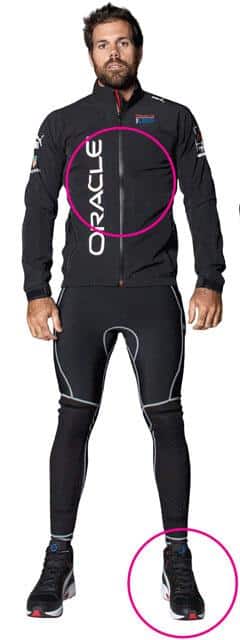
High-top sneakers
Rolled ankles and torn ligaments are the most common injuries incurred while crossing the net at high speeds, so PUMA’s custom high-top sneakers give better support than traditional sailing footwear. The robust outsole has trail-running style lugs that grip the net. The grinders prefer a wider, more robust heel platform.
Race jacket
A windproof, waterproof, form-fitting, and high-stretch cycling-style jacket. “Wearing tight layers is especially an issue for the grinders,” says Falcone, “but this one’s not too tight.” This is Falcone’s all-purpose jacket that he can wear on warmer training days and race days. For the Cup, we can expect high-visibility colors incorporated into the jacket.

Buoyancy aid
The flotation of this PFD from Forward Sailing (Switzerland) is concentrated in the rib cage area, which gives the sailors some chest and back impact protection. The design also provides useable space for modifications. A sleeve holding a spare-air bottle and personal safety knife is located on the front of the PFD. On the lower-back portion they’ve modified it in-house to provide a pouch for a hydration pack (the feed tube runs up the shoulder). A final design may include a quick-release mechanism that allows them to easily remove the PFD should they be trapped under the boat or wing.
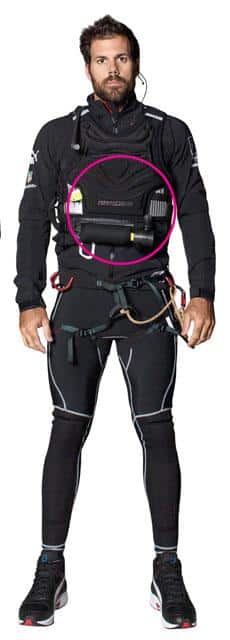
Spare air
Every sailor is required to carry a personal spare air tank, which provides approximately 30 breaths. “If you don’t have it, you don’t go on the boat,” says Falcone.
Safety knife
The preference is for a fixed, straight-blade knife because a serrated blade can’t effectively cut a slack line, and a foldable knife could be problematic if the sailor is trapped. Some crewmembers also carry “hook” blades that allow them to cut through netting. Extra knives are mounted elsewhere on the boat.
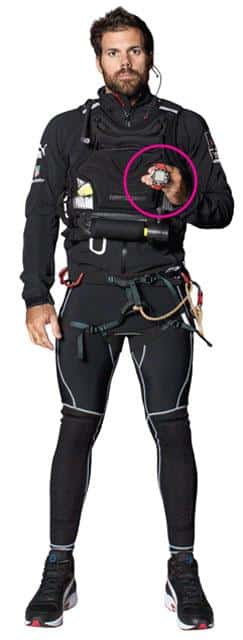
PDA watch
Custom Tag Heuer watches with touch-screen displays allow each crewmember to access wirelessly transmitted performance data specific to their position, i.e., hydraulic oil pressure, windspeed, time-to-boundary, wing and jib sheet loads—on demand and automatically.
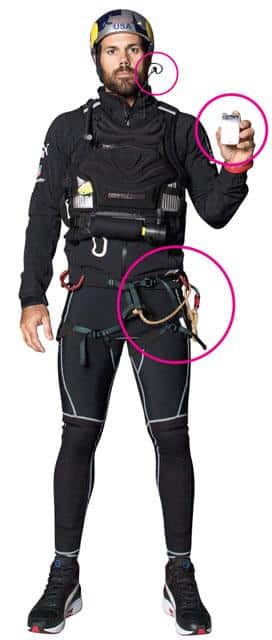
Remote PDA
Each sailor will have a PDA that delivers streaming data, replacing the need for displays, wires, and power sources. Some crews will wear it on their forearm, others will mount it in their cockpit.
Communications unit
Every sailor wears a wireless communication unit, but only skipper Jimmy Spithill has talk capability. Regatta-mandated broadcast communication devices will be sleeved somewhere on the buoyancy aid as well.
Climbing harness
Every sailor on the boat wears one. In the event of a capsize, the carabineer allows them to clip into the netting “for initial impact.” It also allows them to belay an injured crewmember from an upturned hull.
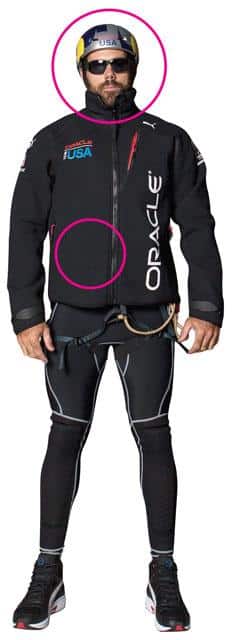
Helmet
The helmet sailors prefer is lightweight and provides good visibility. Following Artemis Racing’s capsize, Falcone and other teams are exploring alternative designs that have impact-energy dissipation technology.
Keep warm jacket
This windproof, heavyweight layer can be worn before and between races for heat retention, and stored on the chase boat during races.
Sunglasses
Developed with Tag Heuer, the sailors’ shades have high-quality glass polarized lenses (with the polarity skewed to allow the sailors to read displays). Because of high winds and spray blowing across the boat, the frames are designed to provide wide facial coverage. Spithill will have a heads-up display integrated into his sunglasses.

